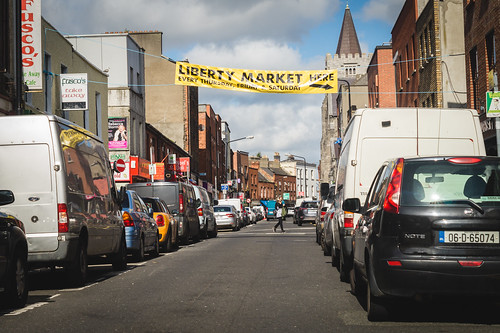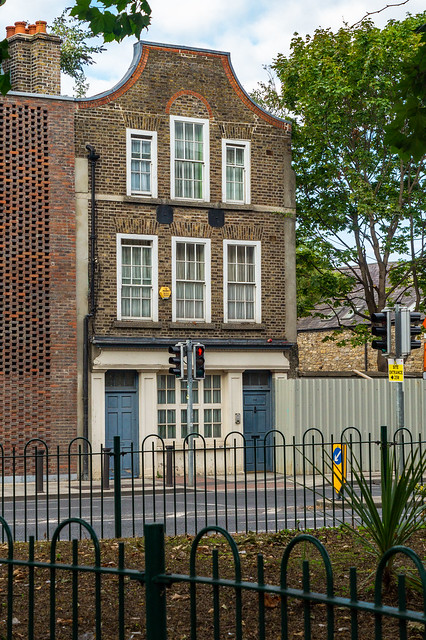Walking down Cork Street towards the Coombe and the City Center you will come across various industrial units. Some still in use, others have been vacant for years. It seems a puzzling locale to anyone born in the last 30 years and accustomed to the existence of industrial estates scattered through the suburbs of Dublin. It is a street now dominated by apartments and modern retail units but for several hundred years it was a center of industry and employment in Dublin. Cork Street and the wider area are known as the liberties. In pre-reformation days, the land adjoining certain monasteries was exempt from civil law but was administered instead by ecclesiastical law. Such lands were known as liberties. Cork Street to the Coombe were part of the Liberty of St. Thomas and Donore. In 1177, King Henry II founded the monastery as an act for contrition for his role in the murder of St. Thomas a Beckett. The site of the monastery was on Thomas Street where St. Catherine’s Church now stands. The land southwards to Donore ( about 100 acres) was the liberty of the monastery.
The monks were very industrious and contributed much to the medieval city. Dublin’s water supply during this period came from the river Poddle. It rises near the present location of Tymon Park between the Tallaght/Greenhills area and makes its way through Kimmage and Harold’s Cross. It flowed as an open stream through the Blackpitts and around St. Patrick’s Cathedral before entering the Harbor of Dubh Linn which was located at the rear of Dublin Castle. The monks constructed a narrow canal over two miles in length linking the Dodder at Balrothery with the Poddle at Kimmage. This combined stream brought nearly 3 million liters of water into the city every day. The Stream was divided into two before Mount Argus at the stone boat.one third taking a new course along what is now known as Sundrive Road through Dolphins barn and filling the reservoir in the City Basin on James Street. The other two thirds of the stream followed the original course through Harold’s cross, but when it reached monastery land it was diverted east, west and north joining rejoining the original course at the foot of new street. This copious supply of water enabled the monks to establish more mills breweries and other industries requiring water. The monks continued working in the area until 1538, when Henry VIII dissolved the monastery. He granted the liberty to William Brabazon, the under treasurer for Ireland. His grandson was ennobled as the Earl of Meath and the seized lands became known as the Earl of Meath’s liberty. The road linking Thomas street and his palace located off present day Newmarket Square became known as Meath street and Brabazon street.
The Protestant Reformation was in full swing throughout Europe at this time and one such Church founded during this period was the Reformed Church of France. It’s followers became known as the Hugenots. During the 16th century they accounted for nearly ten percent of the overall French population. Conflict and warfare over religion were rife during this period until 1598 when the French King Henry IV issued the Edict of Nantes which granted the Huguenots substantial religious, political and military autonomy until the rule of Louis XIV, who gradually increased persecution of Protestantism until he issued the Edict of Fontainebleau in 1685, ultimately ending any legal recognition of Protestantism in France and forcing the Huguenots to either convert or flee. Ten years later King William III gave a portion of the Liberty to the banished Hugenots following their service under his banner during the Jacobite Wars. They were weavers by profession and they began laying out streets and building gable fronted houses after the fashion in northern France. These buildings became known in Dublin as Dutch Billys. Soon there was quite a colony of weavers there, with a loom in every house. They were silk weavers, but as silk thread was not plentiful in Ireland, they mixed it with wool and produced poplin, which was once in great vogue in Dublin, but is not used much nowadays except for gentleman’s ties and church vestments. The weavers were a turbulent crowd and had a long standing sectarian feud with the butchers of Ormond market on the other side of the Liffey. Clashes between them were frequent. On one occasion the butchers hung a number of the weavers by their belts from meat hooks outside their premises.
Up until the middle of the 19th century the liberty was not under the jurisdiction of the Corporation of Dublin and did not have to pay municipal rates. This exemption attracted many industries to the district. Thousands of people found employment and over 100 companies were situated on the Poddle between Kimmage and the Coombe. These included saw mills, cloth mills, paper mills, breweries, distilleries, bacon curing and chemical works. The substitution of steam power for water power drastically reduced the number of these industries in the latter half of the 19th century. This change, together with a decline in the use of poplin reduced the prosperity of this once flourishing district to a very low ebb. The gable fronted houses which were once a major feature of the area became derelict within a few years and were replaced by modern buildings. Scarcely a trace remains today of the once populous Hugenot colony that filled the area bar a couple of houses which have been restored and preserved.











